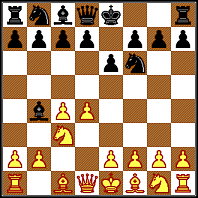And if White can win, how one should play?
To get answers for this questions all you have to do: activate a program which tests all possible variants (like ChessExplorer), put initial position on the board, order to search mate in 50 (or more) moves and ... wait enough time.
Time of expectation would be really long, because number of chess variants is colossal.
Let's try to estimate this number.
Begining game White has 20 possibilities. In next move Black has 20 possible moves, also.
That is in two initial single moves are 400 differents game's variants.
This number of possible continuations quickly grows:
| in 3 first moves | - | 8,902 | |
| in 4 first moves | - | 197,281 | |
| in 5 first moves | - | 4,865,609 | |
| in 6 first moves | - | 119,060,324 |
In the last number are: 9,771,632 variants with first move 1. e2 - e4 and only 4,463,267 with 1. a2 - a3.
Analysing this above numbers you may notice that White is here a little privileged. In 3-th move (White) there is an average of 22.26 possible replies (8902:400), whereas in 4-th move (Black) - 24.16, in 5-th (White) - 24.66 and in 6-th (Black) - 24.47.
Within next moves average number of possible moves groves by differential manner, dependent on used opening.
A few most popular openings:
|
Sicilian Game 1. e2 - e4, c7 - c5 2. Nf1 - f3, Nb8 -c6 3. d2 - d4, c5 x d4 On this position amount of possible continuations:
|
 |
|
King's Gambit 1. e2 - e4, e7 - e5 2. f2 - f4, d7 - d5 3. e x d5, e5 - e4 Number of possible continuations:
|
 |
|
King's Indian Defense 1. d2 - d4, Ng8 - f6 2. c2 - c4, g7 - g6 3. Nb1 - c3, Bf8 - g7 Number of possible continuations:
|
 |
|
Nimzo-Indian Defense 1. d2 - d4, Ng8 - f6 2. c2 - c4, e7 - e6 3. Nb1 - c3, Bf8 - b4 Number of possible continuations:
|
 |
Here is wisible that, for exemple, in Sicilian Defense Black has less possibilities of manoeuvre than White, whereas in King's Gambit - on the contrary.
In middle game number of possible variants, dependent on the position, ranges from about 20 to 50 possible replies in each move.
In endgame number of pieces on the board is mostly smaller as well number of possible variants is smaller.
Let's now to count complete amount of chess variants.
- In first 3 full moves is 119 millions of variants, that is 108.
- Let's assume that in 27 moves (from 4. to 30.) in each is 1000 variants (about 32 in single move).
- In 5 moves (31. - 35.) - 500 variants per full move.
- In 5 moves (36. - 40.) - 200 variants per full move.
- In 10 moves (41. - 50.) - 100 variants per full move.
If a computer will analyse 3,000,000 variants per second, we will receive the result after ... 10120 years !
Yes! We have quantity of possible chess games: 10134 .
And second question: what's quantity of possible positions on chessboard?
This problem is exactly defined but difficult to solution. We can try to dissolve this following way.
For every possible quantity of pieces (from 2 to 32):
- we count number of possible, different sets of pieces
- we take representative set of pieces and we count quantity of possible arrangements on chessboard (they should here to be only legal and possible positions).
For example, with two pieces we have only one set: two Kings.
With 3 pieces it exists 10 different sets (two Kings and one from 10 other pieces). With 4 pieces - 55 sets (they can here to be two Queens of one colour also).
For 16 pieces it exists ca 809,000 sets and for 24 pieces - ca 13,000,000. For 32 pieces we have only one set (promotion of pawn is impossible without capture).
Difficult is counting number of possible arrangements for given set of pieces. Unfortunatelly, this numbers are much larger and this they decide about final result).
Two pieces (white&black Kings) we can put on chessboard onto 3,612 ways (they can not checks themselves).
For 14 pieces (I put here 2 Kings, 1 white Queen, 2 white Rooks, 3 white Pawns, 1 black Queen, 1 black Rook, 3 black Pawns) I got 6.1021 possible arrangements.
I received largest quantities ( from 1029 to 1033 ) for numbers of pieces from 22 to 25.
Above numbers are already corrected with coefficients for eliminate illegal positions.
Final result - total quantity of possible positions on chessboard - accord to my calculations, he hesitated from 1038 to 1041.
I think it is here to accepting number 1040.
 Up
Up